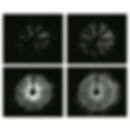



High-Pulse-Rate Pulsed Inductive Thruster (HiPeR-PIT)

Sponsor: NASA Marshall Spaceflight Center
Personnel: Curtis Promislow, Arvindh Sharma, Justin Little (PI)
Inductive pulsed plasma thrusters (IPPTs) are a class of electric propulsion (EP) device that accelerate plasma via the interaction of self-generated electromagnetic fields with those arising from currents induced in the plasma. The High Pulse Rate Pulsed Inductive Thruster (HiPeR-PIT) is a compact multi-kilowatt class planar IPPT designed to operate at high repetition rates (1kHz - 10kHz) with steady propellant injection. This mode of operation has been theorized to result in high thruster efficiency while also eliminating performance and lifetime limiting high speed pulse valves. The HiPeR-PIT research effort consists of two related branches: 1) The study of gas breakdown, inductive energy coupling, and current sheet formation and stability at the low per-pulse discharge energies characteristic of high repetition rate IPPTs and 2) the development of a power processing unit (PPU) for enabling operation at the required high repetition rates.




Scaling, Feasibility, and Mission Design for Plasma Aerocapture

Sponsor: NASA
Personnel: Charlie Kelly, Justin Little (PI)
Aerocapture is an orbital maneuver in which a spacecraft uses atmospheric drag to transfer from an escape trajectory to a stable orbit around a planet. This research focuses on the use of a magnetic dipole plasma to ionize, absorb, and deflect atmospheric flow, generating the requisite drag force without the need for large mechanical structures or high propellant mass. The physics of this device, called a magnetoshell, are not well understood. SPACE Lab is developing analytic models to simulate the magnetoshell/atmosphere interaction so that the performance and physical scaling can be characterized. A novel experimental technique using a hypersonic neutral flow tool is also being used to validate modeling and demonstrate magnetoshell performance.




Non-Equilibrium Plasma Chemistry in Molecular-Propellant Electric Propulsion

Sponsor: NSF
Personnel: Anna Sheppard, Sungyoung Ha, Justin Little (PI)
UW SPACE Lab is researching electric propulsion thrusters operating on alternative propellants. Molecular propellants have more complex plasma chemistry and composition than traditional propellants, but they are appealing because they enable high density storage, in situ resource utilization, and lower propellant cost. These characteristics can expand mission capabilities – longer missions or further away destinations. We are researching how to exploit these benefits while still providing necessary thruster performance. We developed a control volume model incorporating chemical kinetics to predict plasma composition and thruster performance for water vapor, finding self-similarity for thruster performance as a function of electron temperature and neutral propellant pressure times thruster length (Sheppard, Anna J. and Little, Justin M., “Scaling Laws for electrodeless plasma propulsion using water vapor propellant,” PSST 2020 29 045007). Experimental validation and verification of this work using an electron cyclotron resonance thruster is on-going.


Adaptive Hall Thruster with Magnetic Shielding for Alternative Propellant Research

Sponsor: TBA
Personnel: P. Thoreau, D. Dewey, D. Roberts, A. Soval, J. Taylor, J. Little (PI)
The erosion of ceramic channel insulators in Hall thrusters has been the most dominant cause of end-of-life since the first Hall thrusters first flew in 1971. Recent developments in magnetic shielding, a new magnetic field geometry where field lines are tangential to the insulator at the front of the thruster, have reduced channel erosion to negligible levels. However, the switch to a magnetically shielded configuration significantly increases plume divergence contributing to a decrease in thrust. To investigate methods to mitigate the increase in plume divergence, a magnetically shielded hall thruster has been designed with adjustable plume lensing via a variable inset central pole. Changing the inset of the central pole changes the angle of the magnetic field and the location of the peak field. The current in the inner and outer magnetic coils are used to balance the strength and magnitude of the field with the new separation.

Describe your image

Describe your image

Describe your image

Describe your image
Rapid Optimization of Non-Equilibrium Plasmas using New Breakthroughs in Data Science

Sponsor: AFOSR
Personnel: Anna Sheppard, Peter Thoreau, Justin Little (PI)
Background material
